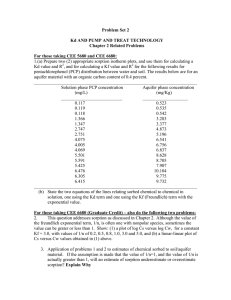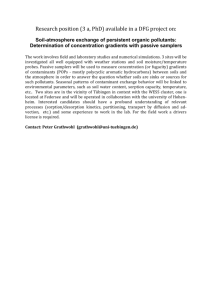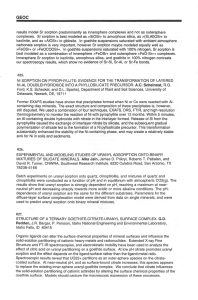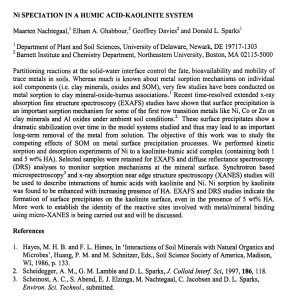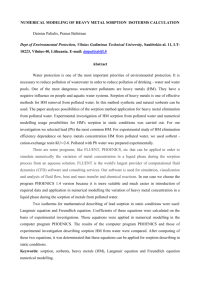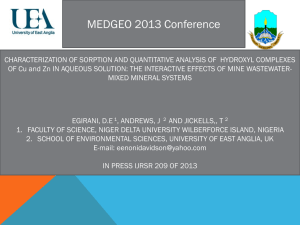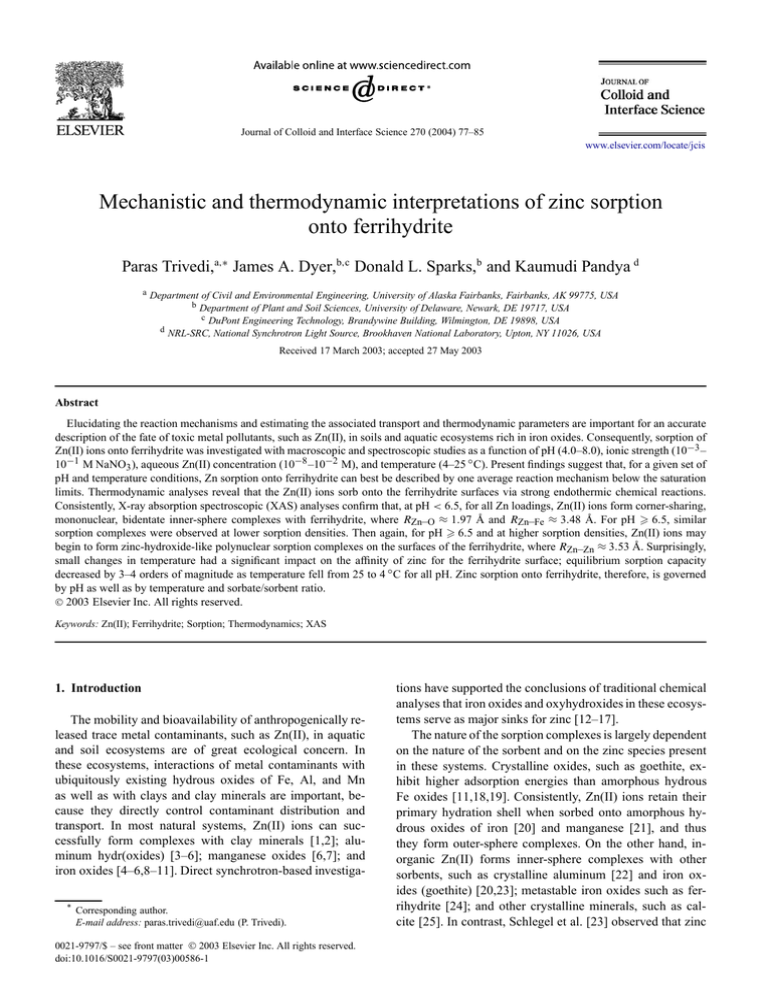
Journal of Colloid and Interface Science 270 (2004) 77–85
www.elsevier.com/locate/jcis
Mechanistic and thermodynamic interpretations of zinc sorption
onto ferrihydrite
Paras Trivedi,a,∗ James A. Dyer,b,c Donald L. Sparks,b and Kaumudi Pandya d
a Department of Civil and Environmental Engineering, University of Alaska Fairbanks, Fairbanks, AK 99775, USA
b Department of Plant and Soil Sciences, University of Delaware, Newark, DE 19717, USA
c DuPont Engineering Technology, Brandywine Building, Wilmington, DE 19898, USA
d NRL-SRC, National Synchrotron Light Source, Brookhaven National Laboratory, Upton, NY 11026, USA
Received 17 March 2003; accepted 27 May 2003
Abstract
Elucidating the reaction mechanisms and estimating the associated transport and thermodynamic parameters are important for an accurate
description of the fate of toxic metal pollutants, such as Zn(II), in soils and aquatic ecosystems rich in iron oxides. Consequently, sorption of
Zn(II) ions onto ferrihydrite was investigated with macroscopic and spectroscopic studies as a function of pH (4.0–8.0), ionic strength (10−3 –
10−1 M NaNO3 ), aqueous Zn(II) concentration (10−8 –10−2 M), and temperature (4–25 ◦ C). Present findings suggest that, for a given set of
pH and temperature conditions, Zn sorption onto ferrihydrite can best be described by one average reaction mechanism below the saturation
limits. Thermodynamic analyses reveal that the Zn(II) ions sorb onto the ferrihydrite surfaces via strong endothermic chemical reactions.
Consistently, X-ray absorption spectroscopic (XAS) analyses confirm that, at pH < 6.5, for all Zn loadings, Zn(II) ions form corner-sharing,
mononuclear, bidentate inner-sphere complexes with ferrihydrite, where RZn–O ≈ 1.97 Å and RZn–Fe ≈ 3.48 Å. For pH 6.5, similar
sorption complexes were observed at lower sorption densities. Then again, for pH 6.5 and at higher sorption densities, Zn(II) ions may
begin to form zinc-hydroxide-like polynuclear sorption complexes on the surfaces of the ferrihydrite, where RZn–Zn ≈ 3.53 Å. Surprisingly,
small changes in temperature had a significant impact on the affinity of zinc for the ferrihydrite surface; equilibrium sorption capacity
decreased by 3–4 orders of magnitude as temperature fell from 25 to 4 ◦ C for all pH. Zinc sorption onto ferrihydrite, therefore, is governed
by pH as well as by temperature and sorbate/sorbent ratio.
2003 Elsevier Inc. All rights reserved.
Keywords: Zn(II); Ferrihydrite; Sorption; Thermodynamics; XAS
1. Introduction
The mobility and bioavailability of anthropogenically released trace metal contaminants, such as Zn(II), in aquatic
and soil ecosystems are of great ecological concern. In
these ecosystems, interactions of metal contaminants with
ubiquitously existing hydrous oxides of Fe, Al, and Mn
as well as with clays and clay minerals are important, because they directly control contaminant distribution and
transport. In most natural systems, Zn(II) ions can successfully form complexes with clay minerals [1,2]; aluminum hydr(oxides) [3–6]; manganese oxides [6,7]; and
iron oxides [4–6,8–11]. Direct synchrotron-based investiga* Corresponding author.
E-mail address: paras.trivedi@uaf.edu (P. Trivedi).
0021-9797/$ – see front matter 2003 Elsevier Inc. All rights reserved.
doi:10.1016/S0021-9797(03)00586-1
tions have supported the conclusions of traditional chemical
analyses that iron oxides and oxyhydroxides in these ecosystems serve as major sinks for zinc [12–17].
The nature of the sorption complexes is largely dependent
on the nature of the sorbent and on the zinc species present
in these systems. Crystalline oxides, such as goethite, exhibit higher adsorption energies than amorphous hydrous
Fe oxides [11,18,19]. Consistently, Zn(II) ions retain their
primary hydration shell when sorbed onto amorphous hydrous oxides of iron [20] and manganese [21], and thus
they form outer-sphere complexes. On the other hand, inorganic Zn(II) forms inner-sphere complexes with other
sorbents, such as crystalline aluminum [22] and iron oxides (goethite) [20,23]; metastable iron oxides such as ferrihydrite [24]; and other crystalline minerals, such as calcite [25]. In contrast, Schlegel et al. [23] observed that zinc
78
P. Trivedi et al. / Journal of Colloid and Interface Science 270 (2004) 77–85
ions complexed with EDTA retained their octahedral hydration shells upon sorption onto goethite. Then again, at
high loadings, with Al-bearing minerals, such as pyrophyllite [2] and alumina [22], Zn(II) binds chemically to form
hydrotalcite-like complexes, whose crystalline stability increases with reaction time. Overall, these studies demonstrate that the nature of zinc sorption complexes depends
on the physical and chemical properties of sorbents as well
as on the concentrations and the forms of Zn(II) species.
Interestingly, on a long-term basis, Zn(II) ions continue to
migrate into the micropores of the sorbent oxides via intraparticle diffusion, where the sorption mechanism has been
found not to change from the one observed on the external
surface [6,9,21].
Recently, Waychunas et al. [24] provided significant insight into the mechanisms controlling the sorption of Zn(II)
ions onto 2-line ferrihydrite in the neutral pH range under multiple reaction conditions. They found that Zn(II)
ions form inner-sphere bidentate complexes with ferrihydrite at lower sorption densities, while they form surface
precipitates of zinc-hydroxide-like polymers at higher sorbate loadings [24]. Although the second shell surrounding the tetrahedrally coordinated sorbed Zn(II) ion is surrounded by as many as four Fe neighbors in the coprecipitates versus two Fe neighbors in the sorption complexes,
the average Zn–Fe bond distance was approximately 3.44 Å
in all systems. Given the complex chemistry of aqueous
Zn(II) species [24], the interactions between Zn(II) and ferrihydrite in aquatic ecosystems can be highly sensitive to
changes in pH, ionic strength, sorbate/sorbent ratio, and
changes in temperature. In order to identify the mechanisms that significantly control the Zn(II)-ferrihydrite interactions, there is a strong need to investigate these reactions over a wide pH range (4.0–8.0) as a function of
varying zinc loadings (10−8 –10−4 M Zn(NO3)2 ) and varying ionic strengths (10−3 –10−1 M NaNO3 ). Additionally,
changes in temperature can significantly alter the nature
of these sorption reactions [6,10,26]. Thermodynamic parameters, such as adsorption enthalpy and entropy, can
provide a much clearer picture of the driving forces involved in the sorption reactions, and they can serve as
important tools for developing accurate predictive models.
The primary objective of this research paper, therefore,
is to elucidate these mechanisms by conducting a systematic set of macroscopic studies complemented with X-ray
absorption spectroscopic analyses over a wide range of
pH, Zn(II) concentrations, ionic strength, and temperature.
Macroscopic studies will be employed to assess the effect
of different factors controlling the sorption of Zn(II) ions
onto ferrihydrite as well as to estimate important transport and thermodynamic parameters that can be used for
predicting the fate of Zn(II) ions in aquatic ecosystems.
The results from X-ray absorption spectroscopy (XAS)
studies will assist in revealing the mechanisms responsible for the sorption reactions. In addition, these mecha-
nisms will be used to support surface complexation modeling of the macroscopic data in the companion paper [27],
the results of which will be used in another companion
paper to simulate and validate Zn(II) removal in multistage aqueous waste treatment systems [28]. Combining
molecular-scale research with macroscopic and thermodynamic modeling over a wide range of reaction conditions
is significant, because it provides a systematic and thorough approach to understanding the speciation and fate
of aqueous Zn(II) in the presence of hydrated iron oxides.
2. Materials and methods
2.1. Macroscopic studies
All the experimental procedures are conducted under
closed system conditions (in the N2 glovebox) and turbulent hydraulic conditions (Re 2.9 × 105 with respect to
reactor diameter). All the experiments used ACS reagentgrade chemicals, double-deionized water, and acid-washed
polypropylene reactors. Ferrihydrite was prepared per the
procedure detailed by Trivedi et al. [29]. The adsorbent’s
physical and chemical characteristics have been described
previously [29,30]. Traditional sorption edge and isotherm
studies were conducted in 250-ml high-density polyethylene
(Nalgene) containers with 1 g l−1 oxide to assess the amount
of contaminant sorbed to the iron oxide as a function of
pH (4.0–8.0), ionic strength (10−3 –10−1 M NaNO3 ), solution concentration (10−8 –10−2 M Zn(NO3 )2 ), and temperature (4–25 ◦ C). The solution concentrations of Zn(II) were
maintained below the solubility limits [31] for Zn(OH)2 and
ZnO. To evaluate maximum sorption capacities, additional
isotherm studies were conducted with a 0.1 g l−1 oxide suspension. Preliminary batch studies were conducted to assess
the kinetics of Zn sorption onto the external surfaces of the
ferrihydrite particles under different pH conditions and under the boundary conditions similar to the ones employed
in traditional isotherm studies. Under these boundary conditions, a contact time of 4 h is sufficient for equilibration
of Zn sorption onto the external surface as well as onto
the macropore walls of the ferrihydrite particles. Furthermore, contributions from intraparticle diffusion of Zn(II)
ions along the micropore walls of ferrihydrite will be insignificant under these boundary conditions [6,29]. Samples
were collected and filtered using 0.2-µm Gelman Supor-200
filters. The filtrate was acidified and analyzed with graphitefurnace atomic absorption spectroscopy (Perkin–Elmer Analyst 800) to determine the bulk aqueous Zn(II) concentrations. For XAS analyses, suspensions from 25 ◦ C studies
were centrifuged at 12,000 g for 20 min to ensure maximum solid–liquid separation. Resultant wet pastes were immediately loaded into acrylic sample holders, which were
sealed with Mylar windows to prevent the loss of moisture.
P. Trivedi et al. / Journal of Colloid and Interface Science 270 (2004) 77–85
79
2.2. XAS data collection
XAS data were acquired on beamline X-11A at the
National Synchrotron Light Source (NSLS), Brookhaven
National Laboratory where the electron beam energy was
2.528–2.8 GeV with a maximum beam current of 280 mA.
Prior to data collection, the beam energy was calibrated
to the first inflection point of the Zn metal foil (E0 =
9.659 keV). The XAS data for the Zn–ferrihydrite sorption samples were collected at the ZnK-edge over the energy range of 9.459–13.915 keV in fluorescence mode using a Lytle detector. The samples were placed 45◦ to the
incident beam. Harmonic rejection was achieved by detuning the monochromator at least 30% of I0 . For each sample, multiple scans were collected to improve the signalto-noise ratio. The XAS data for the reference compounds
including 1.0 mM aqueous solution of Zn(NO3 )2 at pH 2.0
and ZnO were collected over the ZnK-edge in transmission
mode.
The XAS spectra were analyzed using WinXAS (Version 2.1). For each scan, the background X-ray absorbance
was subtracted by fitting a linear polynomial through the preedge region. The edge jump of a background corrected spectrum was normalized with a linear polynomial over 9.759–
9.959 keV. The threshold energy (E0 ) was determined from
the first inflection point in the edge region and was used to
convert the spectra from energy to k-space. A cubic spline
function was employed to account for the atomic absorption
in the absence of backscattering contributions over the range
2.0–10.0 Å−1 . This isolated function produced the XAFS
function (χ(k)), which was then weighted by k 3 to enhance
the higher k-space data. The Bessel window function was
used in Fourier transforms to produce the radial structural
function (RSF) over 2.4–9.2 Å−1 for all sorption samples.
These RSFs are uncorrected for phase shifts.
To obtain the structural information, the Fourier transforms were fit with a Fe-substituted chalcophanite
(ZnMn3O7 ·3H2 O) model generated using FEFF7 [32],
where all the parameters, except the amplitude reduction
factor (S02 ), were allowed to float. A comparison of the
Zn(NO3 )2 solution spectra collected in transmission mode
with that of the fluorescence mode revealed an average amplitude reduction factor (S02 ) of 0.70, which was used in
fitting. In each sample, the E0 shift was constrained to be
equivalent for all shells. The number of parameters varied
during the fitting was always less than the maximum allowed
based on Nfree = (2 × k × R)/π , where Nfree is the number of degrees of freedom, k is the range of k-space being
fit, and R is the range of the R-space. For any given shell,
a good fit was established by minimizing the residual error.
Additionally for each sample, the fitting routine was carried out on their individual scans as well as their averaged
scan to account for the analytical errors. For all samples,
the errors associated with the structural parameters did not
exceed ±20%.
Fig. 1. pH edges of Zn(II) sorption onto ferrihydrite (1 g l−1 ) at 25 ◦ C and
under closed system conditions: effect of ionic strength and initial Zn(II)
concentrations.
3. Results and discussion
3.1. Macroscopic analyses
The sorption edges of Zn(II) sorbed onto ferrihydrite, as
seen in Fig. 1, follow a sigmoid profile. This profile is a characteristic of Zn(II) and is consistent with the ones observed
by others [4,6,11,18,19,33–36]. At all pH > 4.5, the percent of Zn(II) sorbed onto ferrihydrite is independent of the
ionic strength, which suggests chemisorption as the dominant mechanism. Zn sorption onto goethite is also found to
be independent of ionic strength as well as of sorbate/sorbent
ratios employed in the adsorption edge studies [4,11].
To assess the effect of adsorbate concentrations on Zn(II)
sorption to ferrihydrite, traditional isotherm studies were
conducted at pH 4.5, 5.5, 6.5, and 7.5 under closed system
conditions at multiple temperatures (Fig. 2). In all isotherms,
as the sorbate/sorbent ratio increases, the isotherm begins
to plateau, indicating the onset of maximum possible coverage of the sorption sites available on the surface of ferrihydrite. Below this level of site saturation, the amount of
Zn(II) sorbed is linearly proportional to the corresponding
aqueous bulk concentration. Therefore, Zn(II) sorption onto
ferrihydrite can be modeled with one average type of site.
Recently, Criscenti and Sverjensky [37] demonstrated that
sorption of cations, such as Cd(II) and Zn(II), onto hydrous
ferric oxide can be accounted for with the help of a singlesite triple-layer model. Surface complexation modeling of
80
P. Trivedi et al. / Journal of Colloid and Interface Science 270 (2004) 77–85
Fig. 2. Isotherms of Zn(II) sorption onto ferrihydrite (1 g l−1 ) under closed
system conditions at 25 ◦ C and I.S. 10−2 M of NaNO3 : effect of pH and
temperature. Solid points represent experimental data and the lines represent single-site Langmuir fits employed to evaluate the adsorption enthalpies in Fig. 3. Langmuir model parameters presented in Table 1. XAS
studies were conducted on data points marked with ovals.
the macroscopic sorption data from the present studies is discussed in detail in a companion paper [27].
Temperature fluctuations of 20 ◦ C or more (as a result
of seasonal variations) are not uncommon in natural systems. These changes in temperature can significantly alter
the sorption properties of the sorbent as well as the chemistry
of the adsorbates, and hence they will affect the sorption of
the metal contaminants in the natural environment. For example, as shown in Fig. 2, the capacity of ferrihydrite for
zinc at a fixed equilibrium aqueous Zn(II) concentration decreases by 3–4 orders of magnitude as the temperature falls
from 25 to 4 ◦ C for all pH. These results suggest that even
small changes in temperature can significantly alter the distribution and mobility of metal ions in soils and aquatic
sediments that contain significant fractions of iron oxides.
Furthermore, these temperature variations will significantly
impact the performance of wastewater treatment systems
that employ iron oxides, such as ferrihydrite, as metal scavengers. Thus, there is a need for thermodynamic analysis of a
sorption system, as it provides a clearer picture of the driving
forces involved and also serves as a useful tool for predicting
the fate of metal contaminants in natural environments.
Even though the single-site Langmuir model is limited,
in the sense that it does not explicitly account for the electrostatic charges on the mineral surfaces, it is employed
here to fit the isotherm data strictly for estimating the thermodynamic parameters. The resulting Langmuir isotherm
equilibrium constants (K) are employed in the van’t Hoff
model to estimate the adsorption enthalpies of Zn sorption onto ferrihydrite as a function of pH [38]. Because
Zn(II) sorption onto ferrihydrite increases with increasing
temperature, the sorption is endothermic. The adsorption enthalpies (Table 1 and Fig. 3), suggest that Zn(II) ions may
chemisorb to ferrihydrite [38], where the sorption reaction is
provoked by the bond formation. The adsorption enthalpies
in Fig. 3 are slightly smaller than the ones observed for
goethite, which were found to be about 33 kcal mol−1 [6],
but much greater than the ones observed for surfactantmodified montmorillonite [39] and amorphous hydrous oxides of Al, Fe, and Mn, where the adsorption enthalpies
were less than 25 kcal mol−1 [6]. These results corroborate
the hypothesis that the relative binding strength of crystalline oxides, such as goethite, for metals is much greater
than that of nanocrystalline materials, such as ferrihydrite
and highly amorphous hydrous ferric oxide gels [11,18,19].
Rodda et al. [10] noted that the increase in Zn(II) sorption
onto goethite with increasing temperature is also a function
of pH. Bayat [40] investigated Cd(II) and Zn(II) sorption
onto fly ash, which contained 3.30 wt% of iron oxide and
estimated adsorption enthalpies to be 40.2 kcal mol−1 for
Zn(II) and 10.44 kcal mol−1 for Cd(II). Likewise, the adsorption enthalpies for Cd(II) sorption onto goethite [41] and
onto kaolinite [42] were significantly altered with changes
in pH.
Furthermore, based on the equilibrium constants presented in Table 1, the standard state Gibbs free energies
(G0 ) for the sorption reactions were estimated. These energies, ranging from −2.22 to −5.40 kcal mol−1 , are much
smaller in magnitude than the one estimated by Zhu [43]
for the surface precipitation of Zn(II) onto hydrous ferric
oxide (HFO), which is approximately −13.916 kcal mol−1 .
These results suggest that surface precipitation may not be
a significant contributor in the present systems. The positive values of entropies (S 0 ) (Table 1) show the increased
randomness at the solid/solution interface during adsorption.
Given the errors, the entropies (Table 1) did not vary significantly with pH and temperature, suggesting that the net
sorption mechanism may be independent of these parameters [10]. Furthermore, the small entropies indicate that the
ferrihydrite structure did not change significantly as a result
of adsorption.
The estimated maximum sorption capacities of ferrihydrite (Table 1) range from 10−4 to 10−3 moles of Zn g−1 of
ferrihydrite. These sorption capacities are smaller than those
observed for amorphous ferric oxide gels [19,20], but they
are one order of magnitude greater than those reported for
goethite [4,10,11]. These differences in the sorption capacity
can be attributed to two critical factors that define the nature
P. Trivedi et al. / Journal of Colloid and Interface Science 270 (2004) 77–85
81
Table 1
Thermodynamic parameters of zinc sorption onto ferrihydrite based on the single-site Langmuir model
T (◦ C)
K a,b (l mol−1 )
Γmax a,b (mol g−1 )
G0b,c (kcal mol−1 )
24.6
14.0
4.1
1571
388.6
56.67
4.08 × 10−4
4.06 × 10−5
5.60 × 10−6
pH 4.5
−4.36
−3.40
−2.22
24.7
14
4.1
9091
1707
201.6
1.39 × 10−3
9.62 × 10−5
1.92 × 10−5
pH 5.5
−5.39
−4.24
−2.92
24.4
14.1
4.1
9206
1550
203.9
3.45 × 10−3
3.23 × 10−4
4.72 × 10−5
pH 6.5
−5.40
−4.20
−2.93
24.9
14
4.1
9015
1483
194.5
5.21 × 10−3
5.62 × 10−4
7.05 × 10−5
pH 7.5
−5.39
−4.17
−2.91
H 0b,d (kcal mol−1 )
S 0b,e (kcal mol−1 K−1 )
26.91
0.105
0.106
0.105
30.42
0.120
0.121
0.120
30.73
0.121
0.122
0.121
31.00
0.122
0.122
0.122
a Based on the single-site Langmuir isotherm, 1/C = 1/(K × Γ
−1 ferrihydrite, S = M Zn in bulk
max × S) + 1/Γmax , where C = moles Zn sorbed g
aqueous phase at equilibrium, K = equilibrium constant, and Γmax = maximum sorption capacity.
b An error of ±11% is associated with the parameter.
c G0 represents the Gibbs free energy.
d H 0 represents adsorption enthalpy.
e S 0 represents change in adsorption entropy.
of iron oxides/oxyhydroxides—the method of preparation
and the aging period. Interestingly, even the maximum sorption capacities determined from the single-site Langmuir
model (Table 1) are increasing with temperature, indicating an increase in the active sorption sites with temperature.
Consistently, Rodda et al. [10] found that the sorption capacities for Zn(II) on goethite increased with pH as well as with
temperature. These results suggest that even small changes
in the system temperature will significantly impact the sorbent loadings required by wastewater treatment systems that
employ ferrihydrite for the removal of aqueous metal contaminants.
3.2. XAS analyses
Fig. 3. Estimation of enthalpies associated with Zn(II) sorption onto ferrihydrite as a function of pH. The values of the adsorption equilibrium
constants (K) were obtained by fitting the isotherm data with a single-site
Langmuir model (Fig. 2). Solid lines represent the van’t Hoff model and the
slopes of these lines provide the adsorption enthalpies.
The peaks in XAS spectra of Zn–ferrihydrite sorption complexes studied at pH 4.5 (Fig. 4a), 5.5 (Fig. 4b),
6.5 (Fig. 4c), and 7.5 (Fig. 4d) and under varying adsorbate
concentrations are much broader than that of Zn2+ in aqueous solution suggesting sorbed Zn(II) ions may not retain
their primary hydration shell. These spectra have a noisy
and have a beat pattern indicative of at least two different neighbors surrounding the sorbed Zn(II) ion. Based on
XANES analyses, Waychunas et al. [44] found that octahedrally coordinated aqueous Zn(II) species sorb as tetrahedral
complexes onto ferrihydrite. The highly disordered ferrihydrite in the background causes these sorption spectra (Fig. 4)
to be noisier in the higher k region. Although the χ spectra
of Zn–ferrihydrite sorption complexes are similar under all
reaction conditions, they are less noisy at higher pH values
82
P. Trivedi et al. / Journal of Colloid and Interface Science 270 (2004) 77–85
Fig. 4. Background subtracted, normalized, averaged ZnK-edge XAS spectra of Zn–ferrihydrite complexes at 25 ◦ C, and I.S. 10−2 M NaNO3 under
closed system conditions: effect of Zn sorption density (Γ mol of Zn sorbed
g−1 ferrihydrite) and mode of reaction at pH (a) 4.5, (b) 5.5, (c) 6.5, and
(d) 7.5. The spectra for the sorption samples are compared with the averaged ZnK-edge XAS spectrum of 1 mM aqueous Zn(NO3 )2 solution at
pH 2.
and their signal-to-noise ratios improved with the sorbate
concentrations. Furthermore, these sorption spectra do not
resemble those of ZnO or ZnCO3 [16,20], thus ruling out
the possibility of the formation of these precipitates.
The Fourier transforms of the sorption samples
(Figs. 5a–5d), which are uncorrected for the phase shift,
show two distinct shells surrounding the sorbed Zn(II) ion.
Results of the fitting analyses (Table 2) obtained as a result of considering only single scattering from the first and
second shell contributions show that the first shell surrounding the sorbed Zn(II) ion is composed of approximately four
oxygens with an average Zn–O bond distance of 1.97 Å.
This first shell coordination is consistent with the ones observed for Zn sorption complexes with goethite [20], ferrihydrite [24], and alumina powders [22], and it suggests that
Zn(II) ions lose their octahedral primary hydration shell to
sorb onto ferrihydrite surfaces as tetrahedral units. Previous
extensive compilations of the local structures of Zn reference compounds show that aqueous Zn(II) ions have octahedral first shell coordinations with Zn–O distances ranging
Fig. 5. Fourier transforms (magnitude + real part) of ZnK-edge XAS spectra (solid lines) of Zn–ferrihydrite sorption complexes presented as a function of Zn sorption density (Γ mol of Zn sorbed g−1 ferrihydrite) at pH
(a) 4.5, (b) 5.5, (c) 6.5, and (d) 7.5. All spectra are filtered over k-range
2.1–9.2 Å−1 and fitted with a theoretical model of Fe-substituted chalcophanite (dashed lines) from 0.7 to 3.9 Å. Fitting results shown in Table 2.
from 2.10–2.18 Å, whereas most zinc oxides and hydroxides have a tetrahedral unit with an average Zn–O distance
ranging from 1.96–1.99 Å [20,24]. Accordingly, the Zn(II)
ions sorbed onto ferrihydrite do not appear to retain their
primary hydration shell, suggesting that electrostatic forces
may not drive these sorption reactions. Trainor et al. [22] observed that at low sorption densities (<1.1 µmol m−2 ) Zn2+
sorbs to alumina as a mononuclear inner-sphere complex
with tetragonal first shell coordination and an average Zn–O
distance of 1.96 Å. They [22] also observed two additional
oxygen atoms in the first shell at the higher sorption densities; however, they argue that given the short Zn–O distances
(2.01–2.04 Å) in the first shell, these additional oxygens may
be from the alumina surface resulting in distorted octahedra. In contrast, Zn sorbed to pyrophyllite [2], amorphous
HFO [20], goethite [23], and HMO [21] appeared to retain
its octahedral oxygen coordination. In iron oxides, the reactivity of Zn(II) is dependent not only on the degree of
disorder of the sorbents but the method of preparation and
the aging of the oxides. For example, aqueous Zn(II) ions
P. Trivedi et al. / Journal of Colloid and Interface Science 270 (2004) 77–85
were found to be physically sorbed onto a highly disordered
freshly precipitated HFO gel [20]. In contrast, Zn(II) ions
loose their waters of hydration when sorbed onto two-line
ferrihydrite aged for 24 h [24], a two-line ferrihydrite aged
for 48 h (present study), and highly crystalline goethite [20].
Likewise, the differences in the local structures of Zn(II)
sorbed onto goethite as observed by Schlegel et al. [23] and
by Trivedi et al. [20] can arise from the degree of oxide
crystallinity. Because the Zn–O distances in zinc carbonates are also consistent with octahedral coordination [20,
24], they are much larger than ones observed in the present
Zn–ferrihydrite sorption complexes. Hence, the possibility
of the formation of zinc-carbonate-like surface precipitates
can be excluded from the present systems.
In the sorption complexes studied at pH 4.5 and 5.5, the
second shell was best fit with approximately two Fe atoms
at an average bond distance of 3.48 ± 0.01 Å (Table 2). Inclusion of Zn as second-shell neighbors, with or without Fe
atoms, did not provide any stable fits, which is indicative
of insignificant contributions from multinuclear Zn precipitates. Given the uncertainty of 0.05 Å in the Zn–Fe bond
distances, these results are consistent with the ones observed
for various Zn–iron oxide systems, where the sorbed Zn(II)
ions form corner-sharing bidentate complexes with the octahedral Fe units [20,24]. In contrast, a number of other studies [14,23] reported a much smaller Zn–Fe bond distance of
3.12 ± 0.1 Å. Schlegel et al. [23] attributed these short distances to an edge linkage between the Zn octahedra and the
Fe octahedra on the goethite surface. Thus the present analyses insinuate that, at pH 5.5, Zn(II) ions predominantly
bind via chemical forces with ferrihydrite to form cornersharing mononuclear bidentate complexes, which confirms
chemisorption as suggested from the thermodynamic analyses of the macroscopic studies. Furthermore, at these pH
values, the local structure of the sorbed Zn(II) ion is independent of the sorbate/sorbent ratio, which is indicative of
one average type of sorption mechanism. This information
is very important and will assist in the surface complexation
modeling of the isotherm data [27].
At pH 6.5 and 7.5, for the low sorption densities, Zn(II)
ion are observed to form sorption complexes (Table 2) similar to the ones observed at lower pH values. Trainor et
al. [22] also found Zn(II) forming predominantly mononuclear complexes with alumina at pH 7.0 and 8.0 at lower
sorption densities. Interestingly, for the highest Zn loadings
at pH 6.5 as well as for most Zn–ferrihydrite sorption complexes studied at pH 7.5, the second shell can be successfully
fitted with either Fe atoms alone at an average bond distance
of 3.48 Å or with a Zn atom at an average bond distance of
3.53 Å along with the Fe atoms at an average radial distance
of 3.47 Å. Based on the X-ray photoelectron spectroscopic
(XPS) measurements on dried samples of Zn-hydrous ferric oxide sorption complexes, Harvey and Linton [45] observed a similar change in the speciation from monolayered
chemisorbed coverage at pH < 6.5 to Zn(OH)2-like precipitates at higher pH and higher sorption densities. For the
83
Zn–Fe coprecipitate studied at pH 7.5 (Table 2), the second
shell was best fit only when contributions from Zn as well as
from Fe were included. No meaningful fits were obtained
when Zn was considered as the only second shell neighbor; thus the evidence for the formation of Zn precipitates
could not be established. When Fe atoms were considered
as sole contributors to the second shell, the local structures
of the Zn–ferrihydrite complexes (Table 2) do not appear
to vary with pH or the sorbate/sorbent ratio. Manceau et
al. [46] aged a Zn–ferrihydrite coprecipitate under alkaline
conditions and at 70 ◦ C to form a Zn-substituted goethite.
An XAS analyses revealed the second shell to be composed
of Fe atoms with Zn–Fe bond distances ranging from 3.0
to 3.48 Å [46]. With alumina, at higher Zn sorption densities, the Zn–Zn contributions increase, while the Zn–Al
contributions remain unaltered, suggesting the formation of
a hydrotalcite-like mixed metal coprecipitate [22].
In the second scenario, where the second shell is fitted
with Fe and Zn, the weak Zn–Zn contributions suggest that,
with increases in pH and Zn loading, Zn(II) ions may begin
to form corner-sharing polynuclear complexes on the surface of ferrihydrite. Furthermore, the Zn–Zn and the Zn–Fe
distances are consistent with the ones observed in franklinite as well with those in Zn–ferrihydrite systems studied by
Waychunas et al. [24] for similar Zn loadings studied under similar reaction conditions. However, the analyses of the
bulk spectra do not provide any evidence for the formation
of any well-known Zn precipitates. If there are any precipitates forming, then their contributions to the average local
structure are very small. Concurrently, the thermodynamic
analyses presented earlier (Table 1) suggested that surface
precipitation may not be a significant contributor to the overall uptake of Zn(II) by ferrihydrite. At Zn loadings higher
than the ones studied in the present research, Waychunas et
al. [24] observed that these polynuclear complexes serve as
the precursors for a more stable zinc-hydroxide-like precipitate.
4. Summary
In this research, macroscopic studies are complemented
with X-ray absorption spectroscopy to investigate the sorption interactions between inorganic Zn(II) ions and ferrihydrite over a wide range of reactions conditions pertinent
to natural aquatic environments. Traditional macroscopic
studies suggested that one average sorption mechanism can
adequately describe Zn(II) complexation with ferrihydrite.
Thermodynamic parameters, derived from single-site Langmuir model, are broadly indicative of endothermic chemical reactions between Zn(II) ions and the sorption sites
on the ferrihydrite surfaces. Consistently, X-ray absorption
spectroscopic (XAS) analyses confirm that, for pH < 6.5
and at all Zn loadings, Zn(II) ions form corner-sharing,
mononuclear, bidentate inner-sphere complexes with ferrihydrite. At pH 6.5, similar sorption complexes were ob-
84
P. Trivedi et al. / Journal of Colloid and Interface Science 270 (2004) 77–85
Table 2
Structural parameters of Zn(II)–ferrihydrite sorption complexes from XAS analyses
pH
Γ (mol g−1 )
Atom1
N1 a
R1 (Å)b
σ12 (Å2 )c
Atom2
N2 a
R2 (Å)b
σ22 (Å2 )c
E 0 (eV)
% Res.
4.5
4.5
4.5
4 × 10−4
1 × 10−4
1 × 10−5
O
O
O
4.80
4.25
4.61
1.988
1.986
1.986
0.0047
0.0053
0.0056
Fe
Fe
Fe
1.87
1.90
2.24
3.495
3.473
3.484
0.0110
0.0117
0.0131
2.11
1.89
2.37
7.48
6.61
7.44
5.5
5.5
5.5
1 × 10−3
1 × 10−4
1 × 10−5
O
O
O
4.07
3.84
4.11
1.975
1.971
1.977
0.0047
0.0053
0.0057
Fe
Fe
Fe
2.23
1.99
2.14
3.471
3.482
3.474
0.0094
0.0110
0.0122
2.56
2.43
1.79
6.37
3.02
7.28
6.5
1 × 10−3
O
4.07
1.965
0.0048
O
O
O
3.89
3.87
4.12
1.971
1.972
1.972
0.0051
0.0049
0.0056
3.481
3.474
3.527
3.477
3.480
3.471
0.0124
0.0110
0.0110
0.0109
0.0118
0.0131
6.89
8.31
1 × 10−4
1 × 10−4
1 × 10−5
2.27
1.75
0.17
2.03
1.87
2.10
2.29
3.25
6.5
6.5d
6.5
Fe
Fef
Znf
Fe
Fe
Fe
1.46
2.17
2.03
6.77
5.82
6.81
7.5
1 × 10−3
O
3.68
1.977
0.0044
O
3.87
1.975
0.0051
8.41
12.3
1 × 10−5
1 × 10−3
O
O
4.04
3.85
1.981
1.985
0.0055
0.0037
0.0121
0.0110
0.0110
0.0132
0.0110
0.0110
0.0115
0.0110
0.0110
1.32
0.76
7.5
7.5e
3.482
3.471
3.537
3.477
3.445
3.525
3.487
3.501
3.546
7.47
10.8
1 × 10−4
1.79
1.37
0.31
1.87
1.39
0.26
1.97
1.23
1.17
0.45
2.50
7.5
Fe
Fef
Znf
Fe
Fef
Znf
Fe
Fe
Zn
0.93
1.35
7.89
3.81
Note. Γ = sorption density (mol Pb g−1 ferrihydrite), CN = coordination number, R = average radial distance, σ 2 = Debye–Waller factor:
a Uncertainties in coordination numbers are ±20% for the first shell and ±20% for the second shell.
b Variations in R are estimated to be 0.03 Å for first shell and 0.05 for second shell.
c Errors associated with σ 2 are 15% for both shells. All fits obtained using a theoretical model for a Fe-substituted chalcophanite [30].
d Sample studied at I.S. 10−3 M NaNO .
3
e Coprecipitation sample.
f Alternative fits including contributions from Fe and Zn to fit the second shell, where σ 2 were constrained equal.
served at lower sorption densities. Then again, at pH 6.5,
Zn(II) ions may begin to form zinc-hydroxide-like polynuclear sorption complexes on the surfaces of ferrihydrite at
higher sorption densities. Both macroscopic and spectroscopic studies provide no significant evidence for Zn precipitates over the entire range of reaction conditions employed
in this study. Surprisingly, small changes in temperature had
a significant impact on the affinity of zinc for the ferrihydrite surface. As temperature fell from 25 to 4 ◦ C for all
pH, the equilibrium sorption capacity decreased by 3–4 orders of magnitude. Zinc sorption onto ferrihydrite, therefore
is governed by pH as well as by temperature and the sorbate/sorbent ratio. Most importantly, this research asserts
that elucidating the reaction mechanisms as well as estimating the associated transport and thermodynamic parameters
are crucial for accurately describing the fate of toxic metal
pollutants, such as Zn(II), in soils and aquatic ecosystems
rich in iron oxides.
Acknowledgments
Funding from the DuPont Company and the State of
Delaware through the Delaware Research Partnership supported this research. The authors gratefully thank the tech-
nical support of staff at X11A, National Synchrotron Light
Source, Brookhaven National Laboratory (New York). The
authors also thank Dr. Noel Scrivner of DuPont Engineering
Technology for his valuable input on this research.
References
[1] L. Benyahya, J. Garnier, Environ. Sci. Technol. 33 (1999) 1398.
[2] R.G. Ford, D.L. Sparks, Environ. Sci. Technol. 34 (2000) 2479.
[3] D.G. Kinniburgh, M.L. Jackson, J.K. Syers, Soil Sci. Soc. Am. J. 40
(1976) 796.
[4] M. Okazaki, K. Takamidoh, I. Yamane, Soil Sci. Plant Nutr. 32 (1986)
523.
[5] H. Tamura, R. Furuichi, J. Colloid Interface Sci. 195 (1997) 241.
[6] P. Trivedi, L. Axe, Environ. Sci. Technol. 34 (2000) 2215.
[7] R.M. Mc Kenzie, Aust. J. Soil Res. 18 (1980) 61.
[8] M.M. Benjamin, J.O. Leckie, J. Colloid Interface Sci. 79 (1) (1981)
201.
[9] N.J. Barrow, J. Gerth, G.W. Brümmer, J. Soil Sci. 40 (1989) 437.
[10] D.P. Rodda, B.B. Johnson, J.D. Wells, J. Colloid Interface Sci. 184
(1996) 365.
[11] P. Trivedi, L. Axe, J. Colloid Interface Sci. 244 (2001) 221.
[12] D. Hesterberg, D.E. Sayers, W. Zhou, G.M. Plummer, W.P. Robarge,
Environ. Sci. Technol. 31 (1) (1997) 2840.
[13] S.A. Carroll, P.A. O’Day, M. Piechowski, Environ. Sci. Technol. 32
(1998) 956.
[14] P.A. O’Day, S.A. Carroll, G.A. Waychunas, Environ. Sci. Technol. 32
(1998) 943.
P. Trivedi et al. / Journal of Colloid and Interface Science 270 (2004) 77–85
[15] M.D. Buatier, S. Sobanska, F. Elsass, Appl. Geochem. 16 (2001) 1165.
[16] D.R. Roberts, A.C. Scheinost, D.L. Sparks, Environ. Sci. Technol. 36
(2001) 1742.
[17] M. Isaure, A. Laboudigue, A. Manceau, G. Sarret, C. Tiffreau, P.
Trocellier, G. Lamble, J. Hazemann, D. Christopher, Geochim. Cosmochim. Acta 66 (2002) 1549.
[18] L.M. Shuman, Soil Sci. Soc. Am. J. 41 (1977) 703.
[19] P.R. Anderson, M.M. Benjamin, Environ. Sci. Technol. 19 (1985)
1048.
[20] P. Trivedi, L. Axe, T.A. Tyson, J. Colloid Interface Sci. 244 (2001)
230.
[21] P. Trivedi, L. Axe, T.A. Tyson, Environ. Sci. Technol. 35 (2001) 4515.
[22] T.P. Trainor, G.E. Brown Jr., G.A. Parks, J. Colloid Interface Sci. 231
(2000) 359.
[23] M.L. Schlegel, A. Manceau, L. Charlet, J. Phys. IV Fr. 7C-3 (1997)
823.
[24] G.A. Waychunas, C.C. Fuller, J.A. Davis, Geochim. Cosmochim.
Acta 66 (2002) 1119.
[25] E.J. Elzinga, R.J. Reeder, Geochim. Cosmochim. Acta 66 (2002) 3943.
[26] G. Brümmer, J. Gerth, K.G. Tiller, J. Soil Sci. 39 (1988) 37.
[27] J.A. Dyer, P. Trivedi, N.C. Scrivner, D.L. Sparks, submitted for publication.
[28] J.A. Dyer, P. Trivedi, S.J. Sanders, N.C. Scrivner, D.L. Sparks, submitted for publication.
[29] P. Trivedi, J.A. Dyer, D.L. Sparks, Environ. Sci. Technol. 37 (2003)
908.
[30] A.C. Scheinost, S. Abend, K.I. Pandya, D.L. Sparks, Environ. Sci.
Technol. 35 (2001) 1090.
85
[31] J.D. Allison, D.S. Brown, K.J. Novo-Gradac, MINTEQA2/
PRODEFA2: A Geochemical Assessment Model for Environmental System., Center for Exposure Assessment Modeling, U.S.
EPA, 1991.
[32] J.E. Post, D.E. Appleman, Am. Mineral. 73 (1988) 1401.
[33] D.A. Dzombak, F.M.M. Morel, Surface Complexation Modeling: Hydrous Ferric Oxide, Wiley, New York, 1990.
[34] M. Padmanabhan, Aust. J. Soil Res. 21 (1983) 515.
[35] P.R. Anderson, M.M. Benjamin, Environ. Sci. Technol. 24 (1990)
692.
[36] N.Z. Misak, H.F. Ghonemy, T.N. Morcos, J. Colloid Interface Sci. 184
(1996) 31.
[37] L.J. Criscenty, D.A. Sverjensky, J. Colloid Interface Sci. 253 (2002)
329.
[38] H.S. Fogler, Elements of Chemical Engineering, 2nd ed., Prentice–
Hall, Englewood Cliffs, NJ, 1992.
[39] S. Lin, R. Juang, J. Haz. Mater. B 92 (2002) 315.
[40] B. Bayat, Water Air Soil Pollut. 136 (2002) 69.
[41] B.B. Johnson, Environ. Sci. Technol. 24 (1990) 112.
[42] M.J. Angove, B.B. Johnson, J.D. Wells, J. Colloid Interface Sci. 204
(1998) 93.
[43] C. Zhu, Chem. Geol. 188 (2002) 23.
[44] G.A. Waychunas, C.C. Fuller, J.A. Davis, J.J. Rehr, Geochim. Cosmochim. Acta 67 (2003) 1031.
[45] D.T. Harvey, R.W. Linton, Colloids Surf. 11 (1984) 81.
[46] A. Manceau, M.L. Schlegel, M. Musso, V.A. Sole, C. Gauthier,
P.E. Petit, F. Trolard, Geochim. Cosmochim. Acta 64 (2000) 3643.


